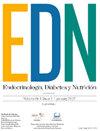Analysis of hypercalcemia in hospitalized patients in Spain from 2001 through 2015
IF 1.8
4区 医学
Q4 ENDOCRINOLOGY & METABOLISM
引用次数: 0
Abstract
Introduction
Few studies have explored the characteristics of hospitalized patients with hypercalcemia. Our goal was to analyze clinical–epidemiological features, mortality, and incidence of hypercalcemia in Spanish adult inpatients.
Materials and methods
We conducted a retrospective study using Spain's nationwide hospital database (“Conjunto Mínimo Básico de Datos Hospitalización”, CMBD-H), analyzing all hospital discharges from 2001 through 2015. Hypercalcemia was defined according to ICD-9-CM code 275.42. We examined causes, sex, median age, length of stay, and in-hospital mortality. Annual rates, adjusted for age and sex, were analyzed too.
Results
A total of 41,103 cases of hypercalcemia were analyzed out of 59,978,703 hospital discharges. Median age was 70 (interquartile range [IQR], 59–79), with 51.3% males. Internal Medicine had the most discharges (32.8%). Hypercalcemia was the leading cause in 11.4% of cases. Most common etiologies were cancer (83.8%) and hyperparathyroidism (15.1%). Neoplasms were more prevalent in males and older patients. Mean incidence was 0.7/1000 admissions, with a 7.1% annual growth rate. The overall in-hospital mortality rate was 27.1%, which remained unchanged over the study period. Factors associated with mortality included increasing age (OR, 1.01; 95% CI, 1.01–1.02), male sex (1.60; 1.53–1.68), emergency admission (1.43; 1.34–1.52), hypercalcemia as main diagnosis (1.89; 1.74–2.06), and neoplasm (5.24; 4.92–5.58).
Conclusions
This is the largest and most comprehensive general study on in-hospital hypercalcemia conducted to this date. The rate of hypercalcemia in hospitalized patients is increasing, likely due to the growing number of cancer inpatients. Hypercalcemia was associated with high mortality.
2001 - 2015年西班牙住院患者高钙血症分析
前言很少有研究探讨住院患者高钙血症的特点。我们的目的是分析西班牙成年住院患者的临床流行病学特征、死亡率和高钙血症发生率。材料和方法我们使用西班牙全国医院数据库(“Conjunto Mínimo Básico de Datos Hospitalización”,CMBD-H)进行了一项回顾性研究,分析了2001年至2015年所有医院的出院情况。根据ICD-9-CM代码275.42定义高钙血症。我们检查了病因、性别、年龄中位数、住院时间和住院死亡率。根据年龄和性别调整后的年增长率也进行了分析。结果在599787703例出院患者中,共分析高钙血症41103例。中位年龄为70岁(四分位间距[IQR], 59-79),男性占51.3%。内科出院最多(32.8%)。高钙血症是主要原因,占11.4%。最常见的病因是癌症(83.8%)和甲状旁腺功能亢进(15.1%)。肿瘤在男性和老年患者中更为普遍。平均发病率为0.7/1000,年增长率为7.1%。总体住院死亡率为27.1%,在研究期间保持不变。与死亡率相关的因素包括年龄增长(OR, 1.01;95% CI, 1.01-1.02),男性(1.60;1.53-1.68),急诊入院(1.43;1.34-1.52),高钙血症为主要诊断(1.89;1.74-2.06),肿瘤(5.24;4.92 - -5.58)。这是迄今为止对院内高钙血症进行的最大规模、最全面的一般性研究。住院患者的高钙血症率正在上升,可能是由于癌症住院患者数量的增加。高钙血症与高死亡率相关。
本文章由计算机程序翻译,如有差异,请以英文原文为准。
求助全文
约1分钟内获得全文
求助全文
来源期刊

Endocrinologia Diabetes Y Nutricion
Multiple-
CiteScore
2.10
自引率
10.50%
发文量
99
期刊介绍:
Endocrinología, Diabetes y Nutrición is the official journal of the Spanish Society of Endocrinology and Nutrition (Sociedad Española de Endocrinología y Nutrición, SEEN) and the Spanish Society of Diabetes (Sociedad Española de Diabetes, SED), and was founded in 1954.
The aim of the journal is to improve knowledge and be a useful tool in practice for clinical and laboratory specialists, trainee physicians, researchers, and nurses interested in endocrinology, diabetes, nutrition and related disciplines.
It is an international journal published in Spanish (print and online) and English (online), covering different fields of endocrinology and metabolism, including diabetes, obesity, and nutrition disorders, as well as the most relevant research produced mainly in Spanish language territories.
The quality of the contents is ensured by a prestigious national and international board, and by a selected panel of specialists involved in a rigorous peer review. The result is that only manuscripts containing high quality research and with utmost interest for clinicians and professionals related in the field are published.
The Journal publishes Original clinical and research articles, Reviews, Special articles, Clinical Guidelines, Position Statements from both societies and Letters to the editor.
Endocrinología, Diabetes y Nutrición can be found at Science Citation Index Expanded, Medline/PubMed and SCOPUS.
 求助内容:
求助内容: 应助结果提醒方式:
应助结果提醒方式:


